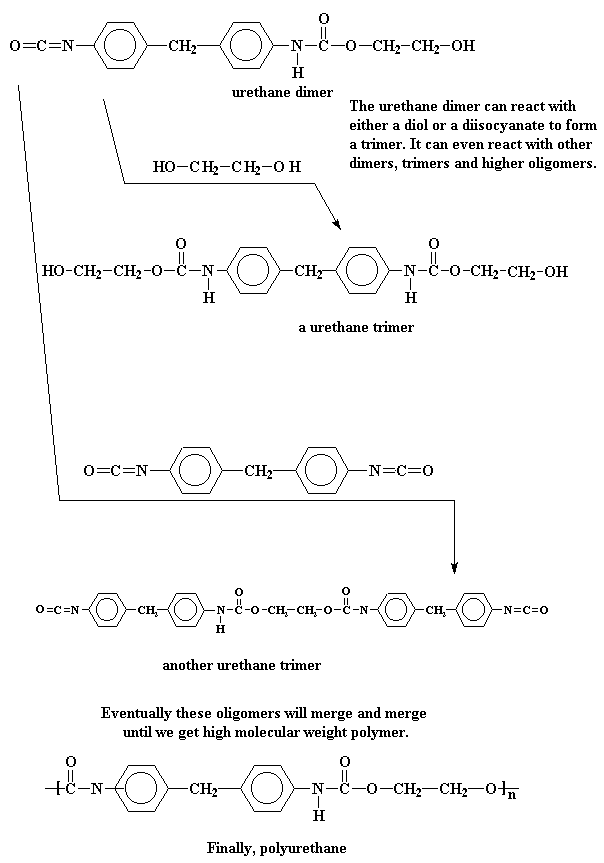This is a most exciting, page, surely it is! This is the page where you the netsurfer will learn how to make polyurethanes! Now, now, it's not that hard. It's quite simple actually. We'll prove it to you...
To start off, we make polyurethanes from two monomers, a diol and a diisocyanate. Can we get a look at them? Yes, there they are, right down below:

We can see them in 3-D by clicking here, if you like.
With the help of a little molecule called diazobicyclo[2.2.2]octane, or DABCO for short, we can make these two polymerize. When we stir the two monomers together with DABCO, something nifty happens.
DABCO is a very good nucleophile, that is, it has a pair of unshared electrons that would just love to attach themselves to a vulnerable nucleus. Remember, electrons have negative charges, and the nuclei of atoms have positive charges. And we all know that negative charges and positive charges attract. So DABCO's electron look around, and they find a nucleus on the alcohol hydrogens of the diol. These hydrogens are vulnerable, because they are bonded to oxygen atoms. Oxygen is electronegative. This is to say it pulls electrons away from other atoms. So it pulls electrons away from its neighbor the hydrogen atom. This leaves the positive charge of its nucleus unbalanced. The electrons would have balanced the positive charge with their own negative charges, they've been sucked away by the oxygen. This leaves a slight positive charge on the hydrogen.

Click here to see a movie of this reaction. So DABCO's electrons see this and they just can't help themselves. They rush over and form a hydrogen bond between the hydrogen and DABCO's nitrogen. This H-bonding leaves a partial positive charge on the nitrogen, but more importantly, a partial negative charge on the oxygen. This partial negative charge makes the oxygen really hot. Being hot as it is, it wants to react with something Would you like to know just what it will react with? The oxygen has an excess of electrons, so it will react with something that is poor in electrons. If we look at our isocyanate, we can see that the carbon in the isocyanate group is sandwiched between two electronegative elements, oxygen and nitrogen. This means that this carbon is going to be very poor in electrons indeed. So our hot oxygen wastes no time in reacting with it. It throws a pair of electrons to that carbon, and a bond forms. 
Click here to see a movie of this reaction. Of course this pushes a pair of electrons out of the carbon-nitrogen double bond. This pair situates itself on the nitrogen, giving it a negative charge. Our oxygen meanwhile, having donated an electron pair, is left with a positive charge.

Now there isn't much that a nitrogen atom likes less than to have a negative charge. So it's going to try to get rid of it as soon as it can. The easiest way to do this is to donate that pair to our old friend, the alcohol hydrogen atom. This forms a bond between that hydrogen and the nitrogen.

 For those of you keeping score at home, you'll notice that not only monomers react, but also dimers, trimers, and so on. This makes it a step growth polymerization. Also, because no small molecule by-products are produced, it is an addition polymerization.
For those of you keeping score at home, you'll notice that not only monomers react, but also dimers, trimers, and so on. This makes it a step growth polymerization. Also, because no small molecule by-products are produced, it is an addition polymerization. Polymers Within Polymers
Sometimes, instead of using a small diol like ethylene glycol, we use a polyglycol, one with a molecular weight of about 2000. This gives us a polymer within a polymer so to speak, and we have a polyurethane that looks something like this:
This gives us a polymer within a polymer so to speak, and we have a polyurethane that looks something like this:  If you like, you can learn how to make a polyurethane foams.
If you like, you can learn how to make a polyurethane foams.
Apakah tersedia juga untuk raw material (monomer) PU untuk membuat PU solid misalnya utk aplikasi Ban pejal?
BalasHapusJika tersedia saya bermaksud membeli. Berapa order minimal?
Trims infonya.
Bagaimana dan dimana untuk bisa belajar membuat polyurethane foams dan dimana alamat/tempat belajar nya.
BalasHapus